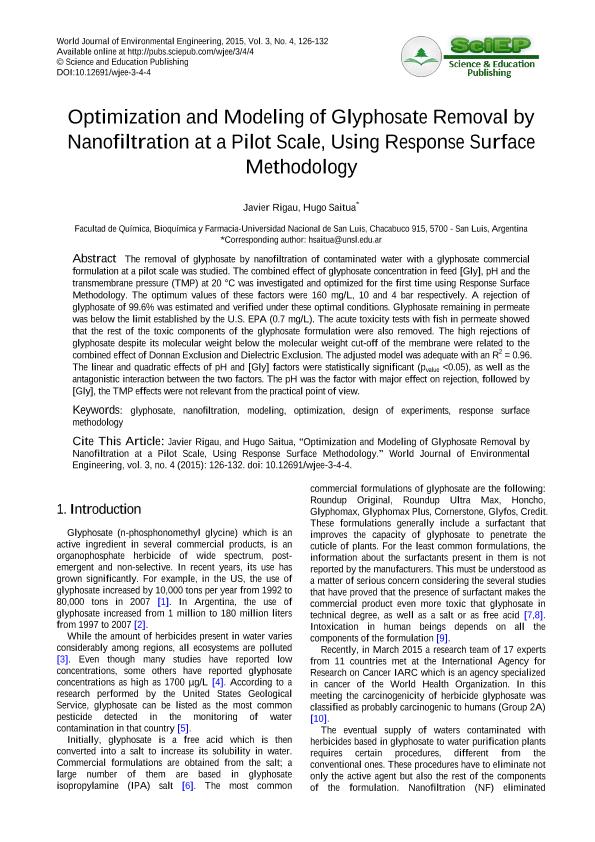Mostrar el registro sencillo del ítem
dc.contributor.author
Tito Rigau, Javier

dc.contributor.author
Saitua, Hugo Alberto

dc.date.available
2018-09-21T17:27:34Z
dc.date.issued
2015-12
dc.identifier.citation
Tito Rigau, Javier; Saitua, Hugo Alberto; Optimization and Modeling of Glyphosate Removal by Nanofiltration at a Pilot Scale, Using Response Surface Methodology; Science and Education Publishing; World Journal of Environmental Engineering; 3; 4; 12-2015; 126-132
dc.identifier.issn
2372-3084
dc.identifier.uri
http://hdl.handle.net/11336/60572
dc.description.abstract
The removal of glyphosate by nanofiltration of contaminated water with a glyphosate commercial formulation at a pilot scale was studied. The combined effect of glyphosate concentration in feed [Gly], pH and the transmembrane pressure (TMP) at 20 °C was investigated and optimized for the first time using Response Surface Methodology. The optimum values of these factors were 160 mg/L, 10 and 4 bar respectively. A rejection of glyphosate of 99.6% was estimated and verified under these optimal conditions. Glyphosate remaining in permeate was below the limit established by the U.S. EPA (0.7 mg/L). The acute toxicity tests with fish in permeate showed that the rest of the toxic components of the glyphosate formulation were also removed. The high rejections of glyphosate despite its molecular weight below the molecular weight cut-off of the membrane were related to the combined effect of Donnan Exclusion and Dielectric Exclusion. The adjusted model was adequate with an R2 = 0.96. The linear and quadratic effects of pH and [Gly] factors were statistically significant (pvalue <0.05), as well as the antagonistic interaction between the two factors. The pH was the factor with major effect on rejection, followed by [Gly], the TMP effects were not relevant from the practical point of view.
dc.format
application/pdf
dc.language.iso
eng
dc.publisher
Science and Education Publishing
dc.rights
info:eu-repo/semantics/openAccess
dc.rights.uri
https://creativecommons.org/licenses/by-nc-sa/2.5/ar/
dc.subject
Ghyphosate
dc.subject
Nanofiltration
dc.subject
Modeling
dc.subject
Optimization
dc.subject.classification
Ingeniería Medioambiental y Geológica, Geotécnicas

dc.subject.classification
Ingeniería del Medio Ambiente

dc.subject.classification
INGENIERÍAS Y TECNOLOGÍAS

dc.title
Optimization and Modeling of Glyphosate Removal by Nanofiltration at a Pilot Scale, Using Response Surface Methodology
dc.type
info:eu-repo/semantics/article
dc.type
info:ar-repo/semantics/artículo
dc.type
info:eu-repo/semantics/publishedVersion
dc.date.updated
2018-09-20T13:12:26Z
dc.journal.volume
3
dc.journal.number
4
dc.journal.pagination
126-132
dc.journal.pais
Estados Unidos

dc.description.fil
Fil: Tito Rigau, Javier. Universidad Nacional de San Luis. Facultad de Química, Bioquímica y Farmacia; Argentina. Consejo Nacional de Investigaciones Científicas y Técnicas; Argentina
dc.description.fil
Fil: Saitua, Hugo Alberto. Universidad Nacional de San Luis. Facultad de Química, Bioquímica y Farmacia; Argentina
dc.journal.title
World Journal of Environmental Engineering
dc.relation.alternativeid
info:eu-repo/semantics/altIdentifier/doi/http://dx.doi.org/10.12691/wjee-3-4-4
dc.relation.alternativeid
info:eu-repo/semantics/altIdentifier/url/http://pubs.sciepub.com/wjee/3/4/4/index.html
Archivos asociados
